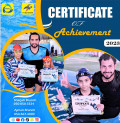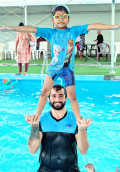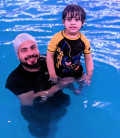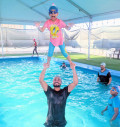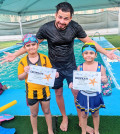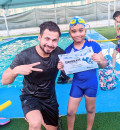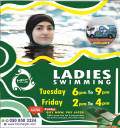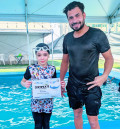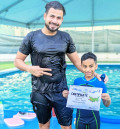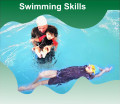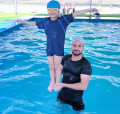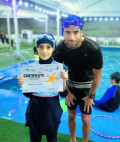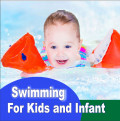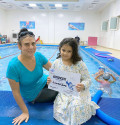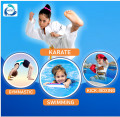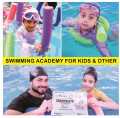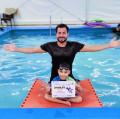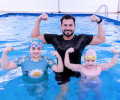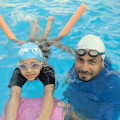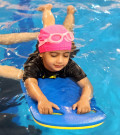
Teaching Swimming to Small Kids A Comprehensive Guide
2024-03-06 - swimmingTeaching small kids how to swim is not just about water
safety; it's an essential life skill that can instill confidence, promote
physical fitness, and foster a love for the water. However, teaching young
children to swim requires patience, dedication, and a carefully planned
approach. In this guide, we'll explore the step-by-step process of teaching
swimming to small kids, from preparation and instruction to overcoming
challenges and celebrating achievements.
1. Introduction to Teaching Swimming to Small Kids
Swimming is not only a valuable life skill but also an
enjoyable activity for children of all ages. However, introducing small kids to
swimming requires a thoughtful and gentle approach. Understanding the
importance of swimming lessons for kids is the first step in ensuring their
safety and enjoyment in the water.
2. Preparing for the Swimming Lessons
Before diving into swimming lessons, it's essential to
gather the necessary equipment and ensure all safety measures are in place.
From swim diapers to flotation devices, preparing for swimming lessons involves
careful planning and attention to detail.
3. Choosing the Right Swimming Instructor
Selecting the right swimming instructor for small kids is
crucial for their success and enjoyment in the water. Factors such as
experience, teaching style, and rapport with children should be considered when
choosing a swimming instructor.
4. Creating a Comfortable Environment
For young children, the unfamiliarity of the water can be
intimidating. Creating a comfortable and welcoming environment is key to making
swimming lessons enjoyable and stress-free. Simple strategies such as singing
songs, using colorful toys, and providing positive reinforcement can help ease
children into the water.
5. Introduction to Basic Swimming Techniques
Once children feel comfortable in the water, it's time to
introduce them to basic swimming techniques. Teaching fundamental skills such
as floating, kicking, and arm movements lays the foundation for future swimming
success.
6. Building Confidence in the Water
Building confidence is essential for small kids learning to
swim. Encouraging them to take risks, praising their efforts, and providing
reassurance can help children overcome fear and gain confidence in the water.
7. Practicing Safety Measures
Safety should always be a top priority when teaching kids to
swim. Teaching children about water safety rules, such as never swimming alone
and always asking for permission before entering the water, can help prevent
accidents and instill responsible swimming habits.
8. Progressive Learning Approach
Implementing a progressive learning approach allows children
to gradually build upon their swimming skills. Starting with simple tasks and
gradually increasing the difficulty level ensures that children feel challenged
but not overwhelmed.
9. Making Swimming Lessons Fun
Making swimming lessons fun and engaging is essential for
keeping kids motivated and excited about learning to swim. Incorporating games,
toys, and playful activities into lessons can help keep children focused and
eager to participate.
10. Encouraging Continuous Improvement
Encouraging continuous improvement is key to helping kids
develop their swimming skills. Providing constructive feedback, setting
achievable goals, and celebrating small victories can motivate children to keep
striving for improvement.
11. Addressing Challenges and Frustrations
Learning to swim can be challenging, and children may
encounter setbacks along the way. Addressing challenges and frustrations with
patience, understanding, and encouragement can help children overcome obstacles
and stay motivated to learn.
12. Transitioning to Advanced Swimming Techniques
As children progress in their swimming abilities, they can
begin learning more advanced techniques such as diving, treading water, and
swimming strokes. Introducing these skills gradually and providing plenty of
practice opportunities ensures that children feel confident and competent in
the water.
13. Promoting Lifelong Swimming Habits
Instilling a love for swimming in small kids can set the
stage for lifelong physical fitness and enjoyment. Encouraging children to
continue swimming regularly, whether for recreation or sport, promotes healthy
habits and a positive relationship with the water.
14. Celebrating Achievements
Recognizing and celebrating children's swimming achievements
is essential for building confidence and self-esteem. Whether it's mastering a
new stroke or swimming a certain distance, acknowledging children's progress
and accomplishments motivates them to continue improving.
15. Conclusion
Teaching swimming to small kids is a rewarding experience
that requires patience, dedication, and a supportive learning environment. By
following a structured approach, focusing on safety, and making lessons fun and
engaging, children can develop essential swimming skills while building
confidence and enjoyment in the water.







.jpg)




















